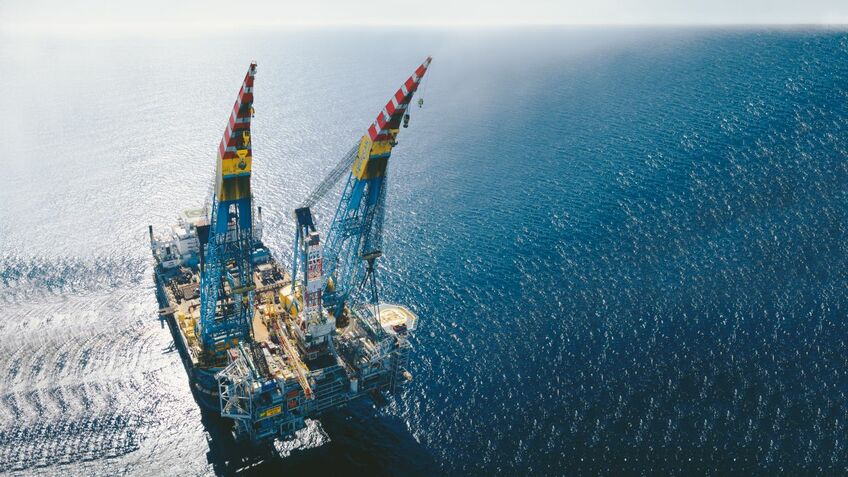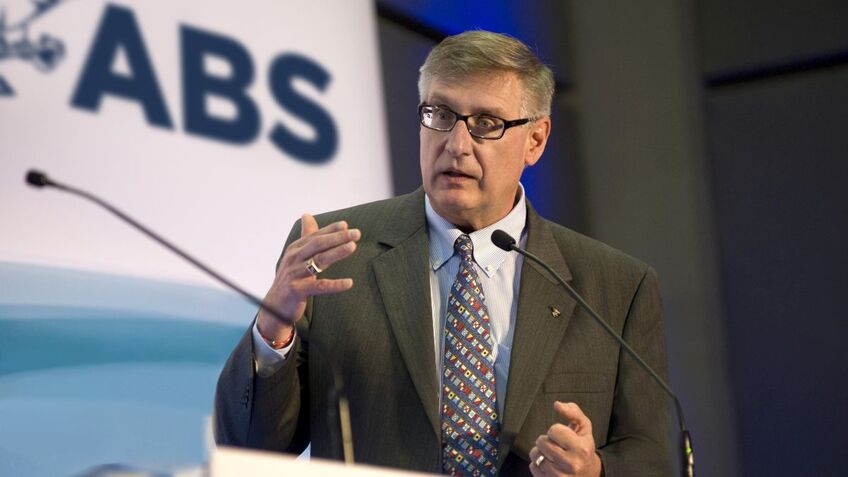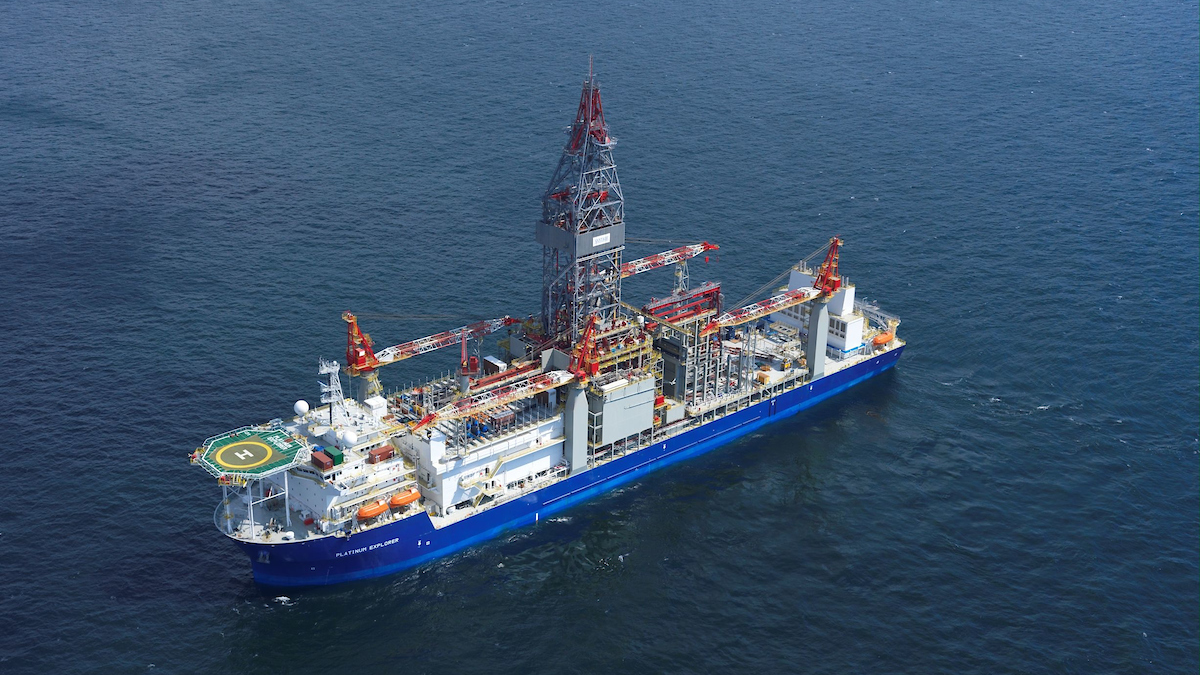Business Sectors
Events
Contents
New propulsors thrust further into OSV market
At the recent OSJ conference, more details emerged of two propulsors that are relatively new to the offshore market, the Voith Schneider Propeller (VSP) and the Combi Drive from Schottel, both of which have now made successful OSV debuts
At present, the Voith Schneider Propeller (VSP) is produced for input powers of up to 3,800kW, with higher figures available upon request. This type of propeller is a well established feature on vessels such as harbour tugs but recently has made a breakthrough into the OSV sector, and the first PSV with VSPs, Østensjø’s Edda Fram, is already in service.
Speaking during a session at the OSJ annual conference dedicated to advances in propulsion, Ivo Beu, who works in the sales and project department at Voith, provided a report on experience to-date with operating Edda Fram using VSPs, and an update on more recent orders from the OSV sector for this type of propeller.
• Apart from Edda Fram and a sister to the 85.20m PSV, Østensjø has also specified VSPs on a 93.40m subsea/inspection, maintenance & repair (IMR) vessel that it has under construction at the Karmsund yard in Norway. In this particular application, two 36R6 ECI300-2 VSPs have been specified against a main power of 2 x 3,800kW.
• Also specified with VSPs is the accommodation vessel building at Astilleros Balenciaga in Spain for Edda Accommodation. This is a particularly interesting application and will see five of these propulsors fitted, the model type in question being 32R5 ECI265-2; delivery of the units for installation on the 130m x 26.40m x 5.40m accommodation ship is scheduled for next year.
• Further references for VSPs are provided by a pair of PSVs for Harms Offshore in Germany. These 103.50m x 22.00m x 6.50m ships are being built at Bharati Shipyard in India and will have a pair of 36R6 ECI300-2 unit specified against main power of 2 x 3,000kW. Delivery of the propellers for these two ships is due later this year.
• Another interesting reference is Voith’s ‘VSP Giant’, as it has dubbed the project, a massive offshore construction vessel for North Sea Shipping in Norway that is on order at Astilleros Barreras in Spain. This 160m x 30.00m x 7.00m vessel will have a quintet of 36R6 EC/280-2 VSPs, with delivery of the propulsors scheduled for 2009.
• Last but not least is an order for a pair of 32R5 EX/265-2 VSPs, due to be delivered this year, for a multi-purpose PSV (MPSV) which is building at Fjellstrand in Norway for an unspecified client. This 84.60m x 16.00m x 5.75m vessel will have a total main power of 5,000kW.
As Mr Beu explained in his presentation, using the latest computational fluid dynamic methods (CFD) in combination with model tests, Voith has continuously improved the hydrodynamic performance of the VSP, and new blade profiles with higher efficiency have been developed. New hull designs using the VSP are now the subject of continuous research and improvement at Voith.
“Benchmark model scale tests have been performed and show the superior efficiency of the VSP over many competitive propulsors,” Mr Beu claimed, noting that apart from acting as propulsors, VSPs also have another valuable roll to play on OSVs, namely roll stabilisation. “Voith Roll Stabilisation System (VRS) allows a significant reduction in rolling motion,” he explained, providing evidence of this feature of the VSP with dramatic video footage showing the reduction in roll achieved on Edda Fram.
As previously highlighted in OSJ, compared with conventional propellers or thrusters, the VSP is a very different propulsion system, allowing the control of thrust in magnitude and direction steplessly, with a very high level of precision, and very quickly.
Mr Beu summarised the main advantages of the VSP on OSVs as the following:
• stepless control of thrust in magnitude and direction
• thrust and propulsion efficiency are equal in all directions
• thrust control corresponds with the ship's main axis
• main engines can be operated at constant or variable speed, adapted to the requirements of manoeuvring, DP and free running condition, taking into account the optimum fuel efficiency, whether the machinery is diesel mechanical or diesel electric
• the VSP is extremely slow running and therefore reliable, with high safety margins in arduous service conditions and a life expectation of at least that of the vessel.
“On a VSP driven OSV, very fast and precise thrust changes are necessary. Such features will be guaranteed by the VSP, with precise manoeuvring and quick response times under both normal and emergency operation conditions, in all circumstances. This aspect will be of paramount importance at offshore installations in heavy weather conditions,” Mr Beu explained, noting that the VSP does not generate side thrust vectors during manoeuvring.
“Another important feature is redundancy of the entire propulsion system, which guarantees full control of a vessel, even with only one power train in operation,” Mr Beu explained. “The very rapid and precise thrust variation, according to Cartesian coordinates, makes the VSP an ideal propulsion system for efficient dynamic positioning, even under extremely difficult weather conditions.”
As highlighted above, the VSP also provides a form of roll stabilisation for an OSV, both in DP mode and free running modes, a role that has been proven by Voith using theoretical computations undertaken with the University of Hamburg/Harburg, model tank testing, and, more recently, full scale measurements in the Atlantic and the North Sea.
“Edda Fram has proven the unique performance of the Voith Schneider Propeller with respect to manoeuvrability, dynamic positioning, redundancy and controllability, following successful trials and in-service experience,” Mr Beu told the conference, noting that Østensjø Rederi and Voith had completed an in-depth analysis of the propulsion efficiency of VSPs on a modern OSV in comparison with other advanced concepts, such as CRPs, over the entire operational range of a vessel, along with an analysis of seakeeping behaviour.
The design and principle of the VSP have been discussed before in OSJ, as have the results of model tests, but turning to the results of the full scale tests, Mr Beu described first the results of speed tests performed during sea trials, prior to commissioning, off the north coast of Spain and in the Atlantic. The speed trials were performed at a draft of 5.60m on an even keel, and the result was exactly as predicted, thus confirming the accuracy of earlier tank tests in Vienna.
Mr Beu then went on to describe the results of tests of the Voith Roll Stabilisation capability on Edda Fram, a feature that Voith believes could have a big influence on safety and comfort on offshore vessels. As the thrust of the VSP can be varied extremely rapidly, it allows a significant reduction of rolling motion by creating a counter moment to that of the wave moment.
Full scale tests with a German buoy-laying vessel in the North Sea, and further tests at Maritime Research Institute Netherlands (Marin) and at the SVA in Potsdam, Germany, revealed that the VSP can provide a 65-93 per cent reduction in rolling motion in irregular seas. “During the trial on Edda Fram we measured the roll motion with VRS on and off (changing every 100 seconds) over two hours. We achieved a reduction in rolling motion of 60 per cent. The conditions for the trial were a GM of around 2.9m and a roll period of 7.3 sec,” Mr Beu explained, noting that the GM during the trials was unrealistically high (the ship had no deck load, and was only carrying ballast water). “We expect much higher reductions with lower GMs and greater roll periods,” he told the conference.
Concluding his presentation, Mr Beu said Voith was confident that the comprehensive joint investigation programme performed by Østensjø Rederi and Voith at Marintek and the SVA Vienna (in addition to the other tests mentioned above), and the sea trials of Edda Fram, had proved the propulsion efficiency of the VSP solution over the entire draft range as well as the entire speed range of a PSV; he also noted that the use of the VSP implied a considerable reduction in energy consumption and hence in emissions. “Furthermore, the excellent seakeeping behaviour was proven, documented and tested, along with other proven advantages of the VSP with respect to redundancy, controllability, fast and extremely precise thrust control in DP mode,” he concluded.
Also the subject of a paper at the conference was the Combi Drive from Schottel, which was discussed by Roland Schwandt, a sales manager in the offshore division at the company.
As this author noted, diesel electric offshore vessels are becoming more and more common, and most use azimuthing thrusters, either for main or auxiliary propulsion during dynamic positioning. Even anchor handlers with a high power requirements are being fitted with diesel-electric azimuthing drives, the thrusters in most cases being conventional mechanically geared arrangements with Z-Drives and, in some cases electrically driven pod systems.
“Both systems have their pros and cons in respect of size, space requirements, initial and operational costs,”
said Mr Schwandt. “The mechanical thruster still has a considerable share in the diesel electric offshore market, but we wanted to establish whether it would be possible to combine the advantages of mechanical thrusters with those of a pod drive, and based on this question we came up with the idea of a combined mechanical azimuthing thruster and a pod drive, in order to gain the advantages of both systems and combine them in one new drive.”
The outcome is the Combi Drive (which has also been described in detail in previous issues of OSJ), a combination of geared propeller shaft and vertically arranged electric motor partly integrated inside the thruster, the upper part with an integrated electric motor and the lower part with a mechanical gearbox. Instead of the upper gear of a mechanical thruster a vertically arranged electric motor tops the lower part of the Combi Drive.
Comparing the Combi Drive with a conventional Z-Drive, Mr Schwandt noted that the Combi Drive has a number of advantages for both owners and yards. “The most obvious benefit for an operator is the missing upper gear set of the Combi Drive, and due to that the mechanical efficiency of the Combi is around 2 per cent higher than a Z-Drive. Reduced mechanical losses can either mean that an owner can install less power and gain some fuel savings, or that he can reach a higher thrust value with the same power.”
The second major advantage for the operator highlighted by Mr Schwandt is the space savings obtained with the Combi Drive, due to the elimination of the shaft line and the partly integrated electric motor. “Space savings mean that the thruster room can be smaller, and the cargo area can be extended, which provides higher profitability for the vessel,” said Mr Schwandt.
Turning to the benefits for a shipyard, Mr Schwandt noted that the elimination of the shaft line not only provides space savings but also means savings in the cost of installation, because the shaftline does not have to be installed or aligned by the yard.
“The integrated electric motor also offers cost savings, not only terms of labour but also in material. This is due to the fact that the shipyard does not have to provide a foundation for the motor or install and align it, and to complete the simplicity of the system the Combi Drive comes with full electric steering which again reduces costs for a shipyard,” reported Mr Schwandt.
As Mr Schwandt went on to note, many of these advantages also accrue from the use of an L-Drive, with which the Combi Drive has some similarities, but compared with the Combi Drive and Z-Drive concepts, the L-Drive has a significant disadvantage, this being its overall height.
“Due to the fact that with an L-Drive the complete electric motor sits outside the thruster, on top of the drive, the L-Drive is much larger than a mechanical Z-drive, which makes it unsuitable for most supply vessels, anchor handlers and similar ships which generally have a very flat aft ship and a very narrow thruster room,” Mr Schwandt explained, noting that, thanks to its partly integrated motor, the Combi Drive is as compact as a mechanical Z-Drive, and around the same height overall, which means that it fits into a supply vessel every bit as well as a Z-drive.
Comparing the Combi Drive with a pod drive, which has no gears and consists basically of a steerable electric motor which is coupled directly to the propeller, Mr Schwandt noted that in terms of mechanical efficiency the pod drive is very efficient, and only has mechanical losses of 1 per cent. Moreover, it has a further advantage over mechanical azimuthing propulsion systems in as much as it uses nearly no lube oil, and hence much reduced risk of pollution.
There are some obvious differences between the Combi Drive and the pod drive which, at the first sight, might give the pod drive an advantage, but Schottel believes that in fact it is the Combi Drive that has most advantages.
“What stands out are the high initial costs of the pod drive compared to a Combi Drive,” said Mr Schwandt, “which is mainly driven by the much more expensive prime mover and the more extensive system. But the question is: is that justified, is the owner getting a much better system for this price? We would clearly say ‘no’ (although a few Schottel pod drives are in operation).”
Turning to the benefits for an operator of the Combi Drive compared to a pod drive, Mr Schwandt said the most obvious one is the lower initial costs of the Combi Drive. Both systems provide similar space savings but, claimed Mr Schwandt, the real advantage is the simplicity of the Combi Drive, which uses a standard water jacket-cooled asynchronous motor which sits inside the vessel and not below the waterline.
“A Combi Drive is much easier to service and maintain. In case of a failure of a drive motor it can easily be exchanged without going to drydock. If a spare motor is available it can be exchanged in one or two days, even with the vessel afloat. A further advantage is the propeller shaft seal – the Combi Drive can use the same standard propeller shaft seal already in service on hundreds of mechanical Z-Drives. A pod drive has a much bigger propeller shaft diameter and needs a special propeller shaft seal. Considering all of the above, we can say that the Combi Drive and the pod drive offer the same space savings advantages and nearly the same efficiency benefits to an operator, but the Combi Drive is less complex, and less complexity is, of course, the basis for higher reliability.”
The first vessel in service with a Combi Drive was Bergensfjord, a 2006-built Norwegian doubled ended ferry which is fitted with four SCD 2020 propulsors (twin-propeller versions without ducts). With this propulsion system the ferry is able to reach a speed of 21 knots. “This application was a really good basis for the first field test of the Combi Drive. With the relatively high speed of the ferry, the system was taken to the design limits and showed how reliably it performs,” said Mr Schwandt.
“We think the Combi Drive fills a gap in the market,” he concluded, noting that when Schottel’s engineers designed the system they kept a quote from Albert Einstein in mind: “Make everything as simple as possible. But not simpler.”OSJ
Related to this Story
Women in Maritime Today: Elin Saltkjel says no day working in maritime is dull
Events
Maritime Environmental Protection Webinar Week
Cyber & Vessel Security Webinar Week
The illusion of safety: what we're getting wrong about crews, tech, and fatigue
Responsible Ship Recycling Forum 2025
© 2024 Riviera Maritime Media Ltd.













